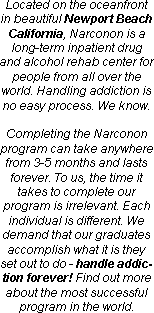
|
Navigate |
| Home |
| Kirstie Alley |
| Our 30th Anniversary |
| Never Turning Back |
| Narconon Endorsements |
| |
|
|
| |
|
|
| |
|
Facts About Drugs |
| FAQ About Ambien |
| FAQ About Ativan |
| FAQ About Cocaine |
| FAQ About Codeine |
| FAQ About Crack |
| FAQ About Darvocet |
| FAQ About Dexedrine |
| FAQ About Demerol |
| FAQ About Dilaudid |
| FAQ About Ecstasy |
| FAQ About GHB |
| FAQ About Heroin |
| FAQ About Hydrocodone |
| FAQ About Ketamine |
| FAQ About Lortab |
| FAQ About LSD |
| FAQ About Marijuana |
| FAQ About Morphine |
| FAQ About Meth |
| FAQ About Methadone |
| FAQ About Opiates |
| FAQ About Opium |
| FAQ About Oxycontin |
| FAQ About Percocet |
| FAQ About Percodan |
| FAQ About Ritalin |
| FAQ About Rohypnol |
| FAQ About Ultram |
| FAQ About Valium |
| FAQ About Vicodin |
| FAQ About Xanax |
  |
|
Resources |

|


 Print this article |  Send this article to a friend |  Add to Favorites |
AAEM Presentation
Presented by David R. Root, MD., 1989
Dr. David Root is a physician specializing in occupational medicine with a private practice in Sacramento. California. He has treated numerous patients who had accumulated lipophilic chemicals through occupational exposure, using the method of detoxification developed by Hub-bard. In the course of his work, he has also treated approximately 75 drug abusers with this detoxification program. He recently reported the results of a follow-up study of these drug abuse patients at the annual meeting of the American Academy of Environmental Medicine.
The long-term success rate for drug and alcohol rehabilitation programs is not extremely high. Abstinence from drugs for 2 years after undergoing rehabilitation treatment by 30% of the patients is considered quite acceptable. This means that 70% of the patients are not succeeding in staying off of drugs. Such a recidivism rate is cause for deep concern. One hypothesis is that a hidden cause of recidivism amongst drug abusers is the presence in their bodies of residual levels of drugs and their metabolites. This led to the proposition that removing these compounds from the body would assist in the recovery of the drug abuser.
One program documented to reduce levels of fat-stored xenobiotics is the detoxification method developed by Hubbard. This program was originally developed to assist in the recovery of drug abusers. The program aims to mobilize and eliminate fat-stored xenobiotics. We have treated drug abusers using this detoxification procedure as the chief component of a drug rehabilitation program.
This program consists of the following components:
|
In the initial interview, the particular needs of the patient are assessed. We refer patients who are addicted to either crack cocaine or to heroin to facilities better able to meet their needs. Drug withdrawal is medically supervised. Drugs are not administered during this step. The patient then undertakes the Hubbard detoxification program. This program lasts for about 30 days. During this phase it sometimes becomes apparent that other factors are reducing a patient’s ability to stay off drugs. In such cases, stress handling is added to the program. The patient identifies those factors or individuals which encourage his or her drug use and works out a program to handle such factors so that they no longer cause him to use drugs. We actively follow up each patient to make sure that he or she is able to stay off of drugs. We have been delivering this program for 5 years. Recently, we conducted a follow-up interview of all available patients to assess the long-term efficacy of this program.
1. PATIENT POPULATION
29 men and 15 women were contacted. Their average age is now 34.2 ± 9.7 years (Range 17 - 73 years.). The average number of years in school was 14.1 ± 2.4 (range 10 - 22) years with an average income of about $30,000/year.
DRUG USE
Drug use had started in these patients at an average age of 16.6 ± 5.1 (range 8-30) years. 27 of those interviewed had used drugs greater than 10 years at the time of treatment. None had used drugs less than one year, three had used drugs I to 3 years and the balance from 4 to 10 years.
At this follow-up interview, 41 of the 45 interviewed (91%) report that they are currently off of drugs. Alcohol was used socially by 22 of those interviewed but none of these reported heavy or uncontrolled drinking. The individual who had undertaken the program specifically for alcohol abuse reported that he no longer used alcohol.
A table of pre- and post-treatment drug use follows. Improvement in drug-abusing behavior was seen for all types of drugs monitored. Those still using drugs are currently using less powerful drugs than they formerly used.
| DRUG
TYPE | PRETREATMENT |
POST-TREATMENT |
| ALCOHOL |
38 |
22 |
| MARIJUANA/HASHISH |
39 |
3 |
| COCAINE |
36 |
0 |
| AMPHETAMINES |
32 |
0 |
| LSD/HALLUCINOGENS |
25 |
0 |
| HEROIN |
8 |
0 |
| OTHER
OPIATES | 14 |
0 |
| ANTIDEPRESSANTS |
13 |
0 |
| OTHERS |
8 |
3 |
POLY DRUG USE
Another way of monitoring the effectiveness of the program is by the number of drugs used by individuals before and after treatment. The average number of drugs used by individuals dropped from 4.7 different drugs before treatment to 0.6 after treatment. Alcohol was still used by all of those reporting drug use after treatment while four individuals reported using additional drugs.
2. FAMILY RELATIONS
At this follow-up interview, patients were asked about their current family relationships as well as their drug use. 23 reported that their family scene was much better, 14 said that it was better, 7 indicated that ii was about the same and I did not answer. None of the patients stated that their family scene had worsened since treatment.
EMPLOYMENT PROFILES
Work situations had also undergone change in some cases. 31 were already holding steady jobs prior to treatment. Following treatment, this number increased to 38. The number working inconsistently dropped from 6 to 3. The number who did nothing went from 5 to 1. The number of students remained the same. Of note, the one individual who supported himself through criminal activities prior to treatment now worked a steady job.
PATIENTS’ OPINIONS
These patients’ opinions of the program were quite encouraging. 29 rated the program as very positive with another 13 rating it positively. 3 were indifferent and none were negative. Of the 45 surveyed, 39 have recommended this program to others.
SUMMARY
In sum, over the last five years, patients with drug abuse problems have been treated with the Hubbard detoxification program, aimed at removing fat-stored xenobiotics. These patients have been assessed by personal follow-up interviews for ongoing drug abuse and social parameters. The reported rates of recovery from these patients are quite high, with 91% of those interviewed reporting no ongoing drug abuse.
These data support the hypothesis that a hidden cause of recidivism amongst drug abusers is the presence in their bodies of residual levels of drugs and their metabolites.

comment corner
 |
| drug rehabilitation saving taxpayers |
California taxpayers are saving more money than expected due to ... |
 |
| Study: Marijuana Causes Lung Damage |
New research finds that smoking three or four marijuana cigarettes ... |
 |
| Thanks to Online Pharmacies, Addiction Can Be Just a Click Away |
WASHINGTON -- Kelly Knable, a 34-year-old mother of three from ... |
 |
| Balancing pain and drug addiction |
Over the past two decades, two conflicting medical ideas have ... |
 |
| Clean break |
... |
 |
| State officials create prescription drug abuse task force |
TALLAHASSEE, Fla. -- State officials on Friday announced the creation ... |
 |
| Florida system often fails to catch Medicaid abuse at source |
FORT LAUDERDALE, Fla. - (KRT) - The victim's skin was ... |
 |
| Marijuana's rising threat: For more kids, use turns into addiction |
John Brown experimented with marijuana at age 10, and it ... |
 |
| Student gets state prison term for selling marijuana |
EASTON -- David Messina had his whole life ahead of ... |
 |
| Man charged in cocaine case forfeits $585,000 |
An Iowa truck driver arrested by Kentucky Vehicle Enforcement officers ... |
 |
| Cocaine Curtails Body's Ability to Cool Off |
In addition to triggering life-threatening cardiovascular episodes, cocaine can be ... |
 |
| Science for Cops |
I admit it: I'm a Law & Order fan. ... |
 |
| New Gene Therapy Could Help Quell Alcoholic Cravings |
One prevailing view of addiction holds that alcohol and other ... |
 |
| One Dose of Cocaine Primes the Brain for Addiction |
It isn't a myth: one dose of cocaine is all ... |
 |
| Marijuana Firmly Linked to Infertility |
Scientists from the University of Buffalo have smoked out what ... |
 |
| Moderate Alcohol Consumption Clouds Brain's Ability to Detect Mistakes |
It's common knowledge that a brain on booze doesn't function ... |
|
Narconon Pictures |
|
   |
|